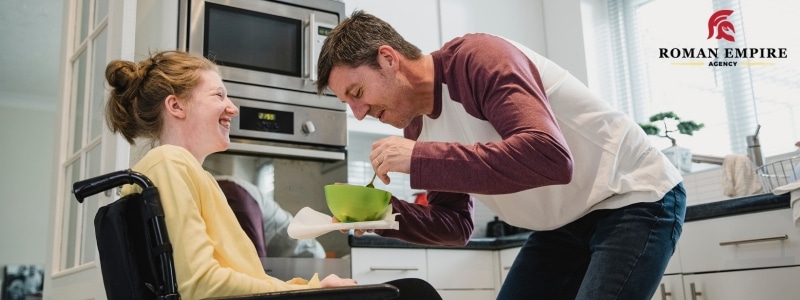It can sometimes be dangerous for a person with a disability to navigate their own home.
In this blog, we’ll discuss:
- What types of disabilities require home safety?
- How do you make a disabled person’s home safe?
- What do you think are the major challenges people with disabilities face at home?
- What are the five barriers for persons with disabilities?
What Types of Disabilities Require Home Safety?

Integration of home safety shouldn’t be limited to one type of disability.
Disabilities can fall into four categories:
- Physical–where typical body movements or control is affected. Disabilities in this category include cerebral palsy, epilepsy, or an injury-related disability.
- Developmental–where typical functions such as language, behavior, and physical and emotional milestones are delayed or not achieved. Disabilities in this category include autism or Down Syndrome.
- Sensory impairment–where the five senses are not at their highest level of function due to an injury, trauma, or genetics. Disabilities can include deafness or blindness.
- Emotional or behavioral–where a person struggles to maintain/create relationships and cope with mental illnesses. Disabilities in this category include Bipolar or ADHD/ADD.
As each category faces different limitations that can impact home life, it’s crucial to include all of them when considering home safety.
For physical disabilities, you may need to restructure your home in a way that is easy to navigate or use.
For developmental disabilities, you may need to take precautions like making a house childproof, such as cabinet locks, gates in front of the stairs, and safe-to-use toys.
For sensory disabilities, you may need to pay attention to overwhelming lighting, colors, and noises.
Finally, emotional or behavioral disabilities may require a pet-friendly environment for ESAs, and safety precautions around any dangerous or sharp object.
How Do You Make a Disabled Person’s Home Safe?

Even typical home structures like door frames or carpets can become trip hazards. It’s essential to make your home not only safer for specific disabilities but also handicap-accessible if necessary.
Included in this are:
- Modified bathtubs, stairs, and toilets
- Grab bars
- Lowered countertops
- Sensor-triggered faucets
- Non-skid floors
- Good and strong lighting
- Folding or pull-out surfaces
It’s been described that stairs are one of the most dangerous places in the home- causing some of the highest at-home death rates. Because of this, it’s essential to ensure that stairs have adequate accommodations, such as carpeted stairs, stair chairs, handrails, or complete remodeling into indoor and outdoor ramps.
Can I Have Strobe Lights in the Home?
Strobe lights should be avoided in the home if you live with someone with a disability. This type of intense and flashing light can be uncomfortable to those sensitive to light, distracting to those with developmental disabilities like ADHD or autism, and dangerous if someone is struggling with epilepsy. Strobe lights can cause nausea, vertigo, or seizures.
What Does Fire Safety in the Home Look Like?
No home is immune to disasters like a home fire. As situations like this are urgent and unpredictable, it’s important to have a plan in place to get any disabled person out safely. The fire department recommends having two memorized exit points with accommodations such as a ramp or wide doorway for a quicker escape.
Next, the department recommends consistently maintaining smoke alarms and fire sprinklers. These sudden alerts can notify someone with a disability, including if they are hard of sight or hearing. Additionally, it’s recommended that you have a uniform fire safety plan between family members and neighbors- this way, everyone knows their role in getting their loved one out safely during an emergency. This can be practiced through at-home “fire drills” or practice sessions.
What Do You Think Are the Major Challenges People With Disabilities Face At Home?

Living with a disability can bring a lot of emotional stress. Most people turn to social and physical isolation as pain or navigation becomes unmanageable. Social engagement can become more limited, as it is harder to maintain movement for independence. This makes it easy to stay at home and shut people out.
Pay close attention to your loved one’s social habits when living at home with a disability! Make sure they are at least engaging with their family, and preferably with friends, peers, or other loved ones as well. This will decrease the risk of anxiety, depression, and hopelessness.
What are the 5 Barriers for Persons with Disabilities?
While people with disabilities are not defined by their disability or held to it, they may face more societal barriers than others. Five general barriers include:
- Physical: Objects or structures that prevent mobility in day-to-day life.
- Social: People with disabilities are more likely to face family violence or difficulty finding jobs or making friends. This creates a social barrier.
- Policy: the need for more awareness or inclusion in community spaces and activities.
- Communication: People with disabilities may have understanding, hearing, speaking, or writing impairments that make communicating challenging.
- Attitude: Stereotypes and stigmas can change people’s perception of those with a disability and cause them to treat them differently.






